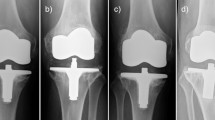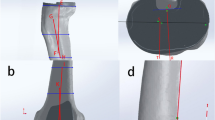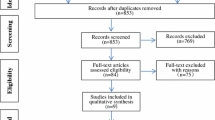Abstract
We compared clinical [including maximal flexion and range of motion (ROM)] and radiographical outcomes of high-flex versus conventional implants for total knee arthroplasty (TKA) after 1 year. We also analyzed the factors affecting postoperative ROM in high-flex implants. The high-flex group (n = 90) had an average maximal flexion of 129.8° (standard deviation (SD), 5.2°) significantly higher than the 124.3° (SD, 9.2°) of the conventional group (n = 90), especially for patients with less than 90° of knee flexion (P < 0.05). There was no significant difference in hospital for special surgery (HSS) score between the two groups. No knee developed osteolysis, aseptic loosening, or other complications. We found that, for high-flex implants, preoperative ROM had a significant effect on postoperative ROM.





Similar content being viewed by others
References
Alejandro L, Luis M, Roman C (1997) Preoperative factors influencing the range of motion after total knee arthroplasty for severe osteoarthritis. J Bone Joint Surg 79-B:626–629
Anouchi YS, McShane M, Kelly F Jr et al (1996) Range of motion in total knee replacement. Clin Orthop 331:87–92
Argenson JA, Scuderi GR, Komistek RD et al (2005) In vivo kinematic evaluation and design considerations related to high flexion in total knee arthroplasty. J Biomech 38:277–284
Bellemans J, Banks S, Victor J et al (2002) Fluoroscopic analysis of the knee kinematics of deep flexion in total knee arthroplasty. Influence of posterior condyle offset. J Bone Joint Surg 84-B:50–53
Chew JTH, Stewart NJ, Hanssen AD et al (1997) Differences in patellar tracking and knee kinetics among three different total knee designs. Clin Orthop 345:87–98
Delp SL, Kocmond JH, Stern SH (1995) Tradeoffs between motion and stability in posterior substituting knee arthroplasty design. J Biomech 28:1155
Dennis DA, Komistek RD, Colwell CE et al (1998) In vivo anteriorposterior femorotibial translation of total knee arthroplasty : a multicenter analysis. Clin Orthop 356:47–57
Dennis DA, Komistek RD, Stiehl JB et al (1998) Range of motion after total knee arthroplasty: the effect of implant design and weight-bearing conditions. J Arthroplasty 3:748–752
Guoan L, Ephrat M, Peter GS et al (2004) Knee kinematics with a high-flexion posterior stabilized total knee prosthesis: an in vitro robotic experimental investigation. J Bone Joint Surg 86-A:1721–1729
Haruo Kawamura, Robert B. Bourne (2001) Factors affecting range of flexion after total knee arthroplasty. J Orthop Sci 6:248–252
Huang HT, Su JY, Wang GJ (2005) The early results of high-flex total knee arthroplasty: a minimum of 2 years of follow-up. J Arthroplasty 20:674–679
Insall JN, Scott WN, Ranawat CS (1979) The total condylar knee prosthesis: a report of two hundred and twenty cases. J Bone Joint Surg 61-A:173–180
Insall JN, Lachiewicz PF, Burstein AH (1982) The posterior stabilized condylar prosthesis: a modification of the total condylar design. Two to four-year clinical experience. J Bone Joint Surg 64-A:1317–1323
Insall JN, Hood RW, Flawn LB et al (1983) The total condylar knee prosthesis in gonarthrosis. J Bone Joint Surg 65-A:619–628
Junji Y, Shin I, Masakazu N et al (2002) Hy-flex II total knee system and range of motion. Arch Orthop Trauma Surg 122:156–160
Kim YH, Sohn KS, Kim JS (2005) Range of motion of standard and high-flexion posterior stabilized total knee prostheses. J Bone Joint Surg 87-A:1470–1475
Laubenthal KN, Smidt GL, Kettlekamp DB (1972) A quantitative analysis of knee motion during activities of daily living. Phys Ther 52:34
McAuley JP, Harrer MF, Ammeen D et al (2002) Outcome of knee arthroplasty in patient with poor preoperative range of motion. Clin Orthop 404:203–207
Merrill AR, Ritter ED (1987) Effect of range of motion on the success of a total knee arthroplasty. J Arthroplasty 2:95–97
Mulholland SJ, Wyss UP (2001) Activities of daily living in non-western cultures: range of motion requirements for hip and knee joint implants. Int J Rehabil Res 24:191–198
Myles CM, Rowe PJ, Walker CR et al (2002) Knee joint functional range of motion prior to and following total knee arthroplasty measured during flexible electrogoniometry. Gait Posture 16:46–54
Nagura T, Dyrby CO, Alexander EJ et al (2002) Mechanical loads at the knee joint during deep flexion. J Orthop Res 20:881–886
Nakagawa S, Kadoya Y, Todo S et al (2000) Tibiofemoral movement 3: full flexion in the living knee studied by MRI. J Bone Joint Surg 82-B:1199–1200
Ritter MA, Campbell ED (1987) Effect of range of motion on the success of a total knee arthroplasty. J Arthroplasty 2:95–97
Schurman DJ, Parker JN, Ornstein D (1985) Total condylar knee replacement. J Bone Joint Surg 67-A:1006–1014
Stern SH, Insall JN (1990) Total knee arthroplasty in obese patients. J Bone Joint Surg 72-A:1400–1404
Author information
Authors and Affiliations
Corresponding author
Rights and permissions
About this article
Cite this article
Bin, S.I., Nam, T.S. Early results of high-flex total knee arthroplasty: comparison study at 1 year after surgery . Knee Surg Sports Traumatol Arthrosc 15, 350–355 (2007). https://doi.org/10.1007/s00167-006-0202-y
Received:
Accepted:
Published:
Issue Date:
DOI: https://doi.org/10.1007/s00167-006-0202-y




